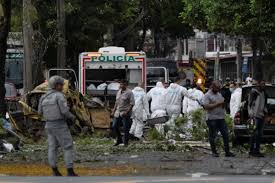
Colombia Drone Strike and Car Bombing Leave at Least 18 Dead

 :
| Updated On: 22-Aug-2025 @ 11:54 am
:
| Updated On: 22-Aug-2025 @ 11:54 amSHARE
At least 18 people were killed and dozens injured in two major attacks in Colombia, both attributed to dissident factions of the disbanded Revolutionary Armed Forces of Colombia (FARC). These violent incidents highlight the country’s persistent struggles with armed groups and its ongoing battle against narcotics-linked violence despite the 2016 peace agreement meant to end decades of conflict.
The first attack took place in Cali, Colombia’s third-largest city. A vehicle loaded with explosives detonated near a military aviation school, killing six people and leaving 71 injured, according to the mayor’s office. This act of violence targeted a critical defense-related institution and underscored the vulnerability of urban centers to guerrilla-style attacks.
Just hours earlier, in the municipality of Amalfi in Antioquia, a National Police Black Hawk helicopter was shot down by a drone while engaged in a coca crop eradication mission. The attack killed 12 police officers on board. Antioquia Governor Andres Julian reported via social media that the drone specifically targeted the helicopter as it flew over coca fields. Defence Minister Pedro Sanchez added that initial findings suggest the drone strike caused a fire inside the helicopter, leading to the fatal crash.
President Gustavo Petro squarely blamed FARC dissidents who had refused to accept the 2016 peace accord. That historic agreement, signed between the Colombian government and the FARC, was supposed to end one of the world’s longest internal armed conflicts, which left more than 450,000 people dead. Yet, dissident factions rejecting the accord remain active, often collaborating with drug cartels.
Initially, Petro suggested that the Gulf Clan, Colombia’s most powerful active drug cartel, was behind the helicopter attack. He argued that the assault may have been in retaliation for a recent cocaine seizure linked to the cartel. Later, however, Petro pointed directly to members of EMC (Estado Mayor Central), a federation of ex-FARC dissidents, as perpetrators. In a post on social media, he shared a photo of a suspect detained for the car bombing in Cali, noting that the individual belonged to EMC and was “subordinate” to drug traffickers.
The situation highlights the complex alliances between FARC dissidents and drug cartels, particularly the Gulf Clan, both of which operate in Antioquia. Petro later announced his intention to have both the Gulf Clan and these armed dissidents officially designated as terrorist groups, enabling stronger measures to pursue them domestically and internationally.
The violence is tied closely to Colombia’s expanding coca cultivation, which fuels the global cocaine trade. According to the United Nations Office on Drugs and Crime, coca farming reached record levels in 2023, with 253,000 hectares (around 625,000 acres) under cultivation. The increasing scale of coca production continues to incentivize violent competition among armed groups seeking control over the trade.
These latest attacks underscore Colombia’s fragile security landscape. Nearly a decade after the peace accord, the government still struggles to enforce stability in regions plagued by narcotics trafficking and guerrilla violence. The helicopter strike and car bombing together reflect how dissident groups are leveraging new technologies, such as drones, alongside traditional bombing tactics, to challenge state authority and sustain their influence in drug-producing territories.